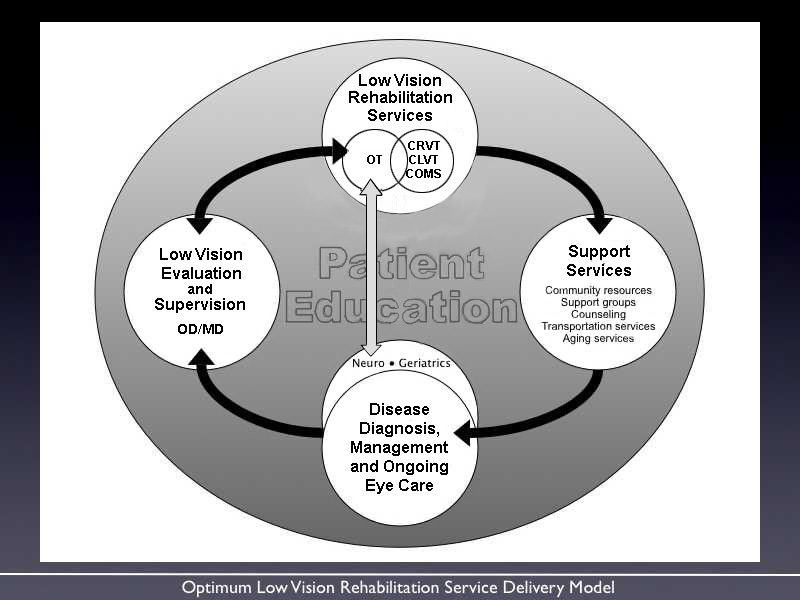The Low Vision Rehabilitation Delivery Model
This is a graphic representation of the Low Vision Rehabilitation Delivery Model as developed by representatives of the four vision academies and a consumer representative.
Below the graphic is a description of each step in the continuum of care it represents. With this information, you hold the key that will open the doors to the care you deserve. You may want to print it and discuss its content with your family and doctor.

Description
The four services are joined in a circle by arrows, representing the paths to follow for optimum low vision rehabilitation service. These images overlay a background labeled “Patient Education,” which is the driving force behind the model. Here are the steps you should expect to take along this road to low vision rehabilitation:
1. The continuum of care may be entered at any point in the circle. The process actually begins, however, when your diagnosing physician (usually an optometrist or ophthalmologist) refers you to a low vision physician for evaluation.
2. The low vision physician (a specially-trained medical doctor or optometrist) will evaluate your needs and refer you, if necessary, to the most appropriate rehabilitation professional/s. You may be referred to one or more of the following:
Certified Low Vision Therapist (CLVT)
Certified Vision Rehabilitation Therapist (CVRT)
Certified Orientation and Mobility Specialist (COMS)
Occupational Therapist (OT)
It could be that you do not need to move further through the system at this time. If not, you will at least know what is available to you if your vision declines further.
3. If you are referred on, rehabilitation professionals will consult and collaborate to provide multi-disciplinary care to meet your needs and goals. At the same time, they should refer you to appropriate ancillary and support services, including:
- Community resources
- Support groups
- Counseling
- Transportation services
- Aging services
4. The support services will provide you with ongoing assistance once formal rehabilitation services have ended. They will ensure that you have the resources to continue the gains made in therapy.
5. If your vision declines, the physician will reinitiate the referral process beginning with a new low vision examination, and the model will progress forward.
Your care providers should be putting this protocol into practice wherever possible. Sufficient manpower and physical resources, however, may not be available in some geographical areas. Hopefully, that situation will improve, as more professionals realize the increasing importance of such care to the quality of life and the health of our low vision community.